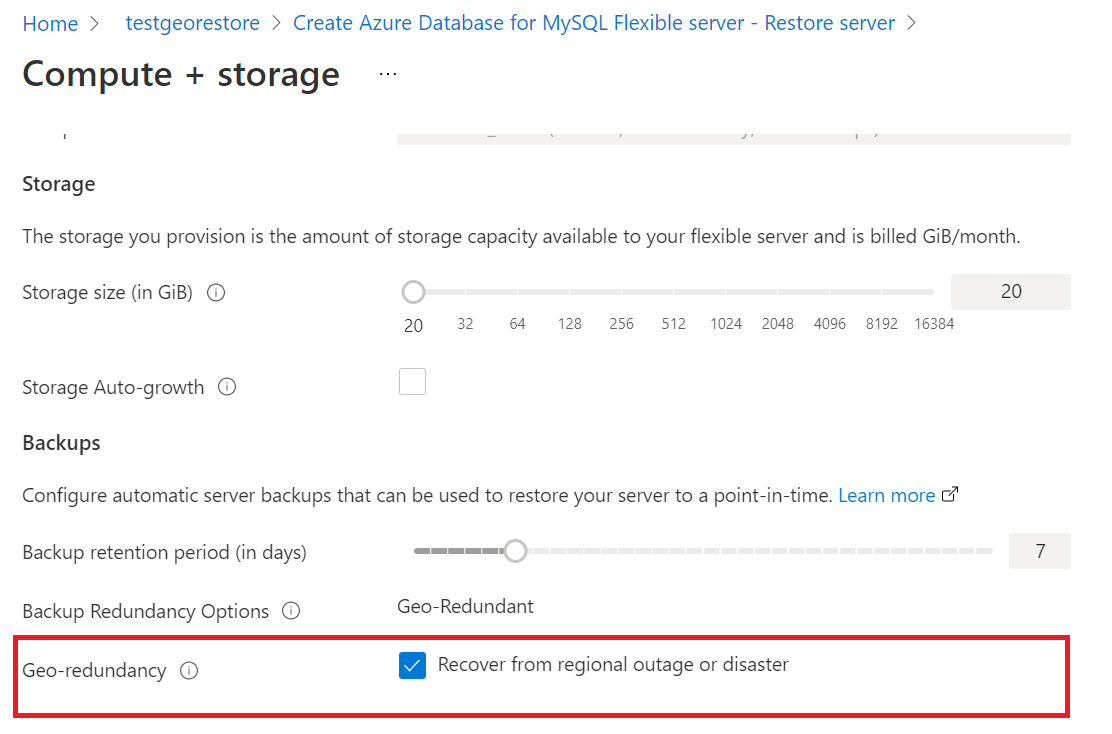Move an Azure Database for MySQL - Flexible Server instance to another region by using the Azure portal
APPLIES TO:  Azure Database for MySQL - Flexible Server
Azure Database for MySQL - Flexible Server
There are various scenarios for moving an existing Azure Database for MySQL flexible server instance from one region to another. For example, you might want to move a production server to another region as part of your disaster recovery planning.
You can use Azure Database for MySQL flexible server's geo restore feature to complete the move to another region. To do so, first ensure geo-redundancy is enabled for your Azure Database for MySQL flexible server instance. Next, trigger geo-restore for your geo-redundant server and move your server to the geo-paired region.
Note
This article focuses on moving your server to a different region. If you want to move your server to a different resource group or subscription, refer to the move article.
Prerequisites
Ensure the source server has geo-redundancy enabled. You can enable geo-redundancy post server-create for locally redundant or same-zone redundant servers. Currently, for a Zone-redundant High Availability server geo-redundancy can only be enabled/disabled at server create time.
Make sure that your source Azure Database for MySQL flexible server instance is deployed in the Azure region that you want to move from.
Move
To move the Azure Database for MySQL flexible server instance to the geo-paired region using the Azure portal, use the following steps:
In the Azure portal, choose your Azure Database for MySQL flexible server instance that you want to restore the backup from.
Select Overview from the left panel.
From the overview page, select Restore.
Restore page is shown with an option to choose Geo-redundant restore. If you have configured your server for geographically redundant backups, the server can be restored to the corresponding Azure paired region and the geo-redundant restore option can be enabled. Geo-redundant restore option restores the server to Latest UTC Now timestamp and hence after selection of Geo-redundant restore, the point-in-time restore options can't be selected simultaneously.
Provide a new server name in the Name field in the Server details section.
When primary region is down, one can't create geo-redundant servers in the respective geo-paired region as storage can't be provisioned in the primary region. One must wait for the primary region to be up to provision geo-redundant servers in the geo-paired region. With the primary region down one can still geo-restore the source server to the geo-paired region by disabling the geo-redundancy option in the Compute + Storage Configure Server settings in the restore portal experience and restore as a locally redundant server to ensure business continuity.
Select Review + Create to review your selections.
A notification is shown that the restore operation has been initiated. This operation may take a few minutes.
The new server created by geo-restore has the same server admin sign-in name and password that was valid for the existing server at the time the restore was initiated. The password can be changed from the new server's Overview page. Additionally during a geo-restore, Networking settings such as virtual network settings and firewall rules can be configured as described in the following section.
Clean up source server
You may want to delete the source Azure Database for MySQL flexible server instance. To do so, use the following steps:
- Once the replica has been created, locate and select your Azure Database for MySQL flexible server source instance.
- In the Overview window, select Delete.
- Type in the name of the source server to confirm you want to delete.
- Select Delete.
Next steps
In this tutorial, you moved an Azure Database for MySQL flexible server instance from one region to another by using the Azure portal and then cleaned up the unneeded source resources.
- Learn more about geo-restore
- Learn more about Azure paired regions supported for Azure Database for MySQL flexible server
- Learn more about business continuity options
Feedback
Coming soon: Throughout 2024 we will be phasing out GitHub Issues as the feedback mechanism for content and replacing it with a new feedback system. For more information see: https://aka.ms/ContentUserFeedback.
Submit and view feedback for




